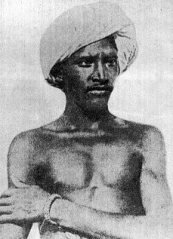 The Chotanagpur region is the adivasi dominated plateau in eastern India, which covers much of Jharkhand as well as adjacent parts of Odisha, West Bengal, Bihar and Chhattisgarh. Almost one hundred years before India’s First War of Independence (1857), the adivasi tribals of Chotanagpur region had declared war against the British colonial rule in the area. The first ever revolt in India, against the landlords and the British government was led by Tilka Manjhi, a valiant Santhal leader from the tribal belt in 1771. The war was not a full fledged nationalist one. Nevertheless, these valiant tribals fought for their land and its resources and most importantly - their rights.
The Chotanagpur region is the adivasi dominated plateau in eastern India, which covers much of Jharkhand as well as adjacent parts of Odisha, West Bengal, Bihar and Chhattisgarh. Almost one hundred years before India’s First War of Independence (1857), the adivasi tribals of Chotanagpur region had declared war against the British colonial rule in the area. The first ever revolt in India, against the landlords and the British government was led by Tilka Manjhi, a valiant Santhal leader from the tribal belt in 1771. The war was not a full fledged nationalist one. Nevertheless, these valiant tribals fought for their land and its resources and most importantly - their rights.
Tilka wanted to liberate his people from the clutches of the unscrupulous landlords and restore the lands of his ancestors. The British government sent its troops and crushed the uprisings. Soon after in 1779, the Bhumij tribes of Manbhum, the Chero tribes of Palamau, the Oraons in Gumla, the Munda tribes of Tamar, the Hos in Singhbhum and the Santhals revolted. The Britishers were given the right treatment for their exploitation of the people and resources of the land. Sidho and Kanho were also two legendary heroes of the Santhal tribals of Chotanagpur who fought against the oppressive rule of the British government.
However, the most celebrated and popular tribal leader of the tribal clan was Birsa Munda.
The British colonial system intensified the transformation of the tribal agrarian system into feudal state. As the tribals with their primitive technology could not generate a surplus, the non-tribal peasantry were invited by the chiefs in Chotanagpur to settle on and cultivate the land. This led to the alienation of the lands held by the tribals. The new class of Thikadars were of a more rapacious kind and eager to make most of their possessions.
By 1874, the aborigines had completely lost their proprietary rights, and had been reduced to the position of farm labourers. To the twin challenges of agrarian breakdown and culture change, Birsa Munda along with his clan responded through a series of revolts and uprisings. The movement sought to assert rights of the Mundas as the real proprietors of the soil, and the expulsion of middlemen and the British. He was treacherously caught on 3rd February 1900 and died in mysterious conditions on 9 June 1900 in Ranchi Jail. Although British government declared that he died of cholera, his body had no symptoms to prove it.
Birsa Munda lived for a very short span of 25 years, but was capable in arousing the tribals and mobilizing them. After his death the movement faded out. However, the movement was significant in at least two ways. First it forced the colonial government to introduce laws so that the land of the tribals could not be easily taken away by the dikus. Second it showed once again that the tribal people had the capacity to protest against injustice and express their anger against colonial rule. They did this in their own way, inventing their own rituals and symbols of struggle. Birsa Munda is today regarded as a god amongst the tribals.
The 20th century saw the dawn of the British policy of “Divide and rule”. One of the most disgusting testaments of this British policy was the partition of Bengal in 1905. Due to this, the tribal areas, although geographically continuous, were put under different administrations. This angered the tribals further. The tribal leaders turned to social and economic development of the people. In 1914 Jatra Oraon started what is called the Tana Movement. Later this movement joined the Satyagrah Movement of Mahatma Gandhi in 1920 and stopped giving land tax to the Government.
In 1915 the Chhotanagpur Unnati Samaj was started for the socio-economic development of the tribals. When the Simon Commission came to Patna in 1928, they faced strong opposition from the Chhotanagpur Unnati Samaj. Thereafter Theble Oraon organised Kishan Sabha in 1931. These organizations were hyperactive in holding the grounds of freedom struggle in India. By the time India won independence, numerous warriors from the forests of Chotanagpur had sacrificed their lives for their rights. Most of the stories still remain untold.
Lest we forget!
